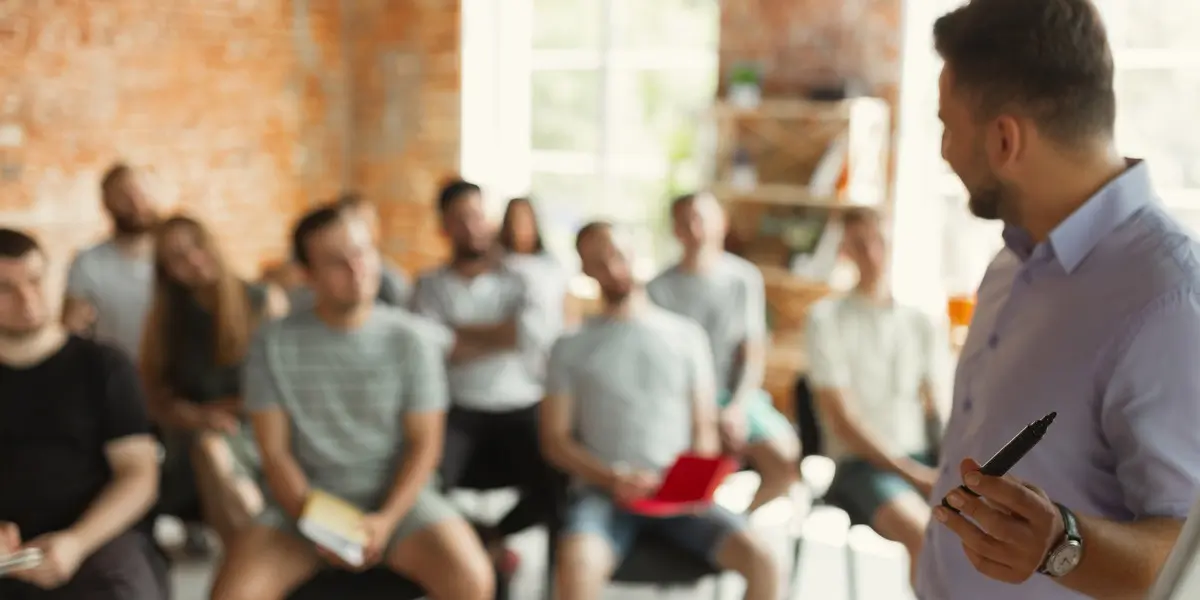Many UX professionals choose to take the knowledge they’ve gained in the field and give it back to prospective designers through mentoring and teaching positions.
But what does a day as a UX instructor really look like?
We sat down with Lead Experience Design Strategist and UX instructor Tony Daussat of Grapevine, Texas for some insights. Throughout this interview, we uncovered what skills are necessary to be a UX instructor, what the salary is like, and some of the biggest do’s and don’ts in the field.
Here’s what we asked:
1. How long have you been a UX designer?
2. What got you interested in UX design?
3. How did you move from UX designer to UX instructor?
4. Can you describe the company you currently work for and your role there?
5. What was your starting salary and how has it changed?
6. What types of students do you have?
7. What is your favorite thing about your current job?
8. What have been your biggest challenges as a UX instructor?
9. What are some “must-haves” for UX instructors?
10. What are some ‘“nice-to-haves” for UX instructors?
11. Best piece of DO advice for people looking to follow a similar career path?
12. Best piece of DON’T advice?

1. How long have you been a UX designer?
I’ve been doing UX work for a while now, since about 10 years ago. I went to college for acting in NYC but to help pay bills I started a photo studio. Then, I moved into doing websites and branding for actors and their side hustles. And finally, I moved from websites into UX.
2. What got you interested in UX design?
Well, I was really bad with package design, physical products, and print design—it was never my gig. So I thought, let me lean into this digital thing. Then, I learned more about human behavior, the psychology of it all, and especially empathy. That made it all start to click. As an actor, it was all about empathy and listening on stage. As a UX designer, it’s all about listening to the user. Then when you incorporate the meetings and workshopping side of UX—it’s pretty much all theatre.
3. How did you move from UX designer to UX instructor?
I started a course called HiredUX.com. I wanted to create the course I wish I had when I started. It’s very cheap and it doesn’t make me rich but I wanted to help as many people as possible. I wanted to take people that were in the same position as I was with no portfolio, no resume, no training, no background—and go from learning the skill sets to getting hired. This and my podcast put me in a sort of mentor position.
For instructing, I started with a guest lecture at Dallas Baptist University about design thinking. Then, Jayneil Dalal (my current co-instructor, CareerFoundry mentor, and host of the podcast Design MBA) met me at a conference in Dallas and wanted to talk about my podcast. Jayneil introduced me to Southern Methodist University (SMU) and we decided to co-instruct a course about breaking into UX. We just got picked up for another fall session and I love it. With Covid-19 of course it’s all on Zoom, but I walk out of my office to my family with so much energy. I’m just jazzed. I like inspiring people.

4. Can you describe the company you currently work for and your role there?
Currently, I have three different jobs. Firstly, I work for Bottle Rocket as an Experience Design Strategist. Bottle Rocket is a premier digital experience firm and here I do a lot of discovery with clients, a lot of high level thinking, research, competitive experience analysis, wireframing based on user journeys and the core demographic needs. This is what you would call my “day job.” I also co-host Liftoff by Bottle Rocket, a podcast formerly known as “Experience Design.”
Then, I have my job as an instructor at SMU with Jayneil. Our style of teaching here is not so structured. We knew the same course was being taught by others who are way more seasoned with 20+ years experience in a much more structured way. But he and I bring a fresh perspective. We prep a little but there’s something about being very raw, candid, and contemporary with a student. Rather than, “I know things and I wanna teach you things’’ we try to say, “I want to listen to how you want to be taught or what you need.” We try to ask, “As someone who may have experienced similar things and might know how to guide you, how can I best serve you? How can I fulfill your needs?”
And on top of all this, I work as a mentor. Usually someone reaches out or I become friends with someone and they ask to be my mentee. Or, because my time is limited, if someone goes through my HiredUX course, there is a free coaching session included. Beyond the free session, there are paid, longer coaching sessions. As much as I would like to devote my whole day to instructing and mentoring, I can’t. Otherwise, I would literally do it all day for free.
5. What was your starting salary and how has it changed?
My first job I was hired at was 35,000 USD—way below the average. But I just wanted to get in. But now, it’s much better. I went from being a traditional UX designer to an Experience Design Strategist along with teaching and mentoring. I’m hesitant to be totally transparent about salary, especially because I came in hot. And that’s part of what I teach too. That what you bring is valuable and there’s always room to negotiate. But for now, let’s just say it’s a healthy income to support my family.
Glassdoor estimates UX/Web Design Instructors make an average of 52,691 USD per year with a low of 38,000 USD and a high of 74,000 USD.
6. What types of students do you have?
My students range anywhere from people about to graduate college to people wanting to change career paths at 40. It’s an interesting dynamic when someone is older than you. That imposter syndrome comes in where I think, ‘Man, they are more seasoned than I am.’ And then they say, “Well not in UX, not in design!” I try to stay open when I’m mentoring or teaching. I don’t want anyone to feel like anyone is better or knows anymore than anyone else.
7. What’s your favorite thing about your current job?
Each job has its own plus. I think it stems from my acting background, but I love people-facing, client-facing work—like workshops and discovery sessions. It feels like the room is buzzing as you try to extract as much info as you can. And the same goes for teaching or instructing. There’s this energy during the exchange of ideas that I love. Especially those moments of realization when their eyes widen and they go, “I never thought of it that way” and I say, “Neither did I!” So, you have these shared moments of revelation that are really nice.
And I can still use my previous career strengths. I did a lot of improv acting in the past and was in an improv troupe in LA and I use those skills every single day.
8. What have been your biggest challenges as a UX instructor?
It’s the theme of a lot of the things I’ve brought up, which is getting over the fact that people have paid for me to teach them how to become a UX designer and get hired. And there is weight to that. I often think, ‘Okay, do I really know the things they’re paying me to know?’ To me, imposter syndrome isn’t exclusive to industry newbies. I would say it compounds over time. It’s hard getting over that and understanding it’s perfectly okay to say I don’t know.
It wasn’t until I was sitting down in an interview and I said, ‘I don’t know anything, but I love my ignorance enough to change it’ that I truly began to get over my imposter syndrome. I had never said it or thought it before, but in that moment it hit me like a ton of bricks. And I’m cool with always being restless and consciously curious.

9. What are some “must-haves” for UX instructors?
You have to be able to communicate. When you hear “communication,” you might think of someone that knows a lot of words, doesn’t say ‘um’ a lot, has a response for everything, or can talk at length without sounding like an idiot. It wasn’t until later that I realized communication skills have nothing to do with any of that. It all goes back to, again, my acting career! Communication and acting are made up of the same things: listening and reacting. That’s all it is—really listening, being present, and reacting. With experience, you’ll gain an understanding of common practices, industry standards etc. that you can speak to more eloquently. But, if you’re not listening you have no communication skills. And it sounds super old school, and it probably is, but I really appreciate eye contact and a meaningful hand shake.
Empathy of course is huge, we can’t speak to that enough as designers and instructors. We have to learn to walk in another person’s shoes. I even spent a day in a wheelchair once just to gain some sort of understanding of what that life would be like. Even doing that for a day I have no real idea of what that experience is like, but you do what you can to gain some insight. Every way someone might be different than you is an opportunity to gain empathy.
And as an instructor you have to have actual experience doing whatever it is you’re teaching. There’s nothing worse than someone trying to give advice when they have little to back it up.
10. What are some ‘“nice-to-haves” for UX instructors?
Technical knowledge is definitely nice to have, especially with the state of the world now (with more schools and other educational organizations going remote).
Two years ago you could get away with only knowing how to use a projector and laptop. But if someone’s only experienced instructing in-person and all of a sudden has to do everything on a screen and needs a camera and the right lighting, microphone, etc., that’s going to throw a huge curve ball at what they thought was paramount to being an instructor.
11. Best piece of DO advice for people looking to follow a similar career path?
It’s never too late to start. Self doubt is normal, literally everyone has it. But, with the internet you can do anything you want to do. I’m completely self taught and still make a healthy income for my family. I was devoted, almost obsessed with YouTube videos, blogs, e-books etc. If you want to do something, the internet is there for you.
And get involved in the design community through local meetups and events. Not in a, ‘what can I get from it’ point of view but from a ‘what can we learn together’ perspective. Consume as much knowledge and content information as you can in the field you want to go into. And of course go to HiredUX.com and take my course.
12. Best piece of DON’T advice?
Oh, there’s so much! I’m gonna rattle off a few…
- Don’t hit ‘apply now’ and assume you are going to get or deserve a response
- Don’t think you are better than anyone else
- Never go into a user testing room wanting to be proven right, seek to be proven wrong
And maybe the most controversial, but…as a UX professional, Dribbble is not your friend. As a UI designer, I get it, it’s a great place for inspiration. But as a UX designer I can’t get anything from a single shot of a final product. That’s not my focus. I want to know everything before. The client, the users, the business goals—all of it should inform the work you do. Not the fancy stuff you see on Dribbble.
In closing
Becoming a UX instructor takes a varied skillset, experience in the field of UX, and a hearty willingness to meet students where they’re at! We hope this interview has given you a glimpse into what that career path can look like, as well as what it’s like to work as a UX instructor.
If you’d like to learn more about forging a career in UX design, here are some articles you’ll find helpful:

